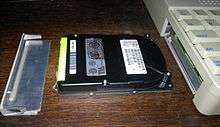Outbound laptop
|
Am Outbound Systems model 2000 | |
| Developer | Outbound Systems Inc. |
|---|---|
| Type | Laptop |
| Release date | 1989 |
| Introductory price | US $4,000 |
| Discontinued | 1991 |
| CPU | Motorola 68000, 15 MHz |
The Outbound laptop was an Apple Macintosh-compatible laptop computer. It was powered by a 15-MHz Motorola 68000 processor. Later versions increased the clock speed to 20 MHz.
Outbound Systems Inc. was located in Boulder, Colorado; but, due to their kangaroo logo, many believed that it was an Australian company.
Laptop
The Outbound laptop was introduced in 1989 and was significantly lighter, at just over 4 kg, and easier to carry than Apple's own Macintosh Portable released at around the same time. Due to Apple's refusal to license the Macintosh Toolbox in read-only memory (ROM), Outbound users had to install a Mac ROM to make the computer work. The ROM was typically removed from an older Mac, a process that would render the donor Mac unusable. Even with this additional cost, a typical price of US $4,000 compared favorably to that of the Mac Portable.
The Outbound featured a built-in pointing device located below the keyboard, named the TrackBar (with earlier models referring to it under the trademark of Isopoint); it was a cylinder that scrolled up and down and slid left and right. It ran on standard camcorder batteries, rather than the expensive custom batteries commonly found in most portable computers around this time.
Notebook
The Outbound laptop was succeeded by the Outbound notebook in 1991.
The Notebook ran on the same style of lead-acid camcorder batteries as the earlier Laptop, and had a 9.7" passive-matrix monochrome LCD display. It used a 2.5" IDE hard drive, which was unusual for the time, as Apple didn't start using IDE drives in PowerBooks until the PowerBook 150 in 1994. The Notebook had an internal microphone and speaker, headphone jack, two serial ports, ADB port, and SCSI port. The Notebook's SCSI port was unique in that it supported the Outbound Outrigger full-page external monochrome monitor, which attached via the SCSI port.
The Notebook's CPU, RAM, Mac ROM, and optional 68882 FPU were mounted on a removable daughtercard. This permitted easy RAM installation and optional upgrades; the daughtercard could simply be swapped out for another one with a faster CPU, or an FPU inserted into the available socket. The daughtercard had four 30-pin SIMM sockets. Due to the Notebook's design, only 4MB of RAM could be addressed by the Mac system software, even in System 7; additional RAM would appear as a "Silicon Disk" which was an Outbound specific RAM disk.
End of Outbound Systems
Apple's introduction of the PowerBook in 1991 led to the demise of the Mac-compatible laptop aftermarket. Probably more significant than the increased competition, was the fact that Outbound was using ROMs under a licensing agreement with Apple. Apple refused to license the use of subsequent proprietary ROMs to Outbound and so the company's ability to manufacture laptops ended when the 68000 processors required by the ROMs to which they had access became difficult to obtain. For a short time after Outbound went out of business, a small group of former employees set up a company, PerFit, to handle service and warranty issues. PerFit ceased operations in 1994.
| Outbound Systems Notebook | ||
|---|---|---|
 The removable hard drive, showing the drive bay and plastic shield. The shield protects the components on the bottom of the drive, as well as having a pull-tab to aid removal of the drive. The cover slides down and out. |
 The components on the bottom of the drive. | |
 The rear connectors of the notebook. |
 The right-hand side of the laptop case. | |
 The TrackBar and two buttons, one on either side of the bar. The TrackBar rolls towards/away from the user, as well as moving left to right. |
 The ROM SIMM removed, showing additional memory modules. The CPU daughtercard slides out of the case to provide access to the RAM slots. | |
 The rear has a memory access panel cover which, once removed, allows access to the CPU daughtercard. | ||
External links
- Outbound Laptop on AppleFritter – review with pictures
- Outbound Laptop on LowEndMac - specifications
- Outbound Notebook on Obsolete Computer Museum - review and pictures of the Notebook model
- Article describing the Outbound Laptop (in French; via Wayback Machine)
- What's Outbound got that Apple doesn't?
